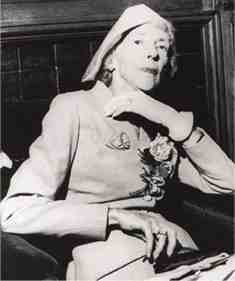Mazo
De La Rocha
Mistress
of Jalna 1879-1961
Mazo de la Roche
is an enigma to anyone wishing to learn about her life. Information that
she gave altered the facts: she changed her date and place of birth, changed
her surname, and rewrote her family’s history. Her first biographers faced
much detective work to establish the details of her life. Yet her fiction
writing was different. The 16 Jalna books deal with many people and cover
more than a century of time. Written over 33 years and not in chronological
order, they are faithful to the larger historical record and inwardly consistent.
A family tree, updated in every volume, shows that Mazo adhered to a strict
time frame. One must conclude that she created historical fiction and fictional
history. She herself said, “I have put myself into my books.” Perhaps that
is ultimately where one can find her.
Born in Newmarket,
Ontario, in 1879, Mazo was the daughter of William and Alberta Roche. Her
mother’s ill health and her father’s many jobs – in stores, in a hotel,
and, lastly, on a farm – resulted in frequent family moves. Mazo drew on
these experiences for her later writing. A high-strung and expressive child
attuned to tragedies and changes around her, she developed a complex fantasy
world that she called “The Play.” This interested and sustained her throughout
her life as she created imaginary scenes and characters, often with her
younger cousin and lifelong companion, Caroline Clement. It too was a rich
source for her writing.
Mazo’s education
combined formal schooling with extensive reading at home and music and
art classes. In 1902, she published her first magazine story and continued
writing as much as she could after that. When in 1927 her Jalna won the
American magazine Atlantic Monthly’s prize of $10,000, she became immediately
famous. The prestigious prize gave her the financial freedom to pursue
writing full-time and to move to Europe. There she lived, mainly in England,
until 1939. Then, with war coming, she returned to North America with her
two adopted children. She spent the rest of her life mostly in Toronto,
where she died at age 82. She was buried at St. George’s Church, at Sutton,
Ontario, on the shore of Lake Simcoe, a place she knew and loved from summer
holidays.
 |
By
the time Variable Winds at Jalna (1954) was published, more than 1.6 million
copies of the Jalna series had been sold to Americans. “Mazo de la Roche’s
achievement as a novelist,” exclaimed Edward Weeks, editor of the Atlantic
Monthly, “makes me think of Trollope and Galsworthy.” In Europe where her
books were translated into 15 languages, the European readership corresponded
directly by the hundreds with the author through her publisher. They wanted
to share with her emotionally how they identified with and were enthralled
by their beloved Whiteoak clan of Jalna. [Dustjacket photo, courtesy Little,
Brown and Company] |
The Jalna series,
her best-known work, chronicles the lives of the Whiteoak family. Jalna,
their family house, was named for the station in India where the first
Whiteoak served before settling with his wife in a community of retired
British officers on Canada’s Lake Ontario shore. The novels are full of
lively, but not always likeable, characters and gripping, yet sometimes
fantastic, plots. They present passionate people against a backdrop of
intense loyalty to family and abiding love of home. They depict nature
as well as people and reveal Mazo’s sensitivity to animals, to changes
of the seasons, and to the beauty of Ontario scenery. Her descriptions
of Britain similarly show her strong relationship to her surroundings.
De la Roche wrote
other books, short stories, and plays. One of these, Growth of a Man (1938),
was about one of her cousins, British Columbia’s lumber magnate, H.R. MacMillan.
A stage version of her Whiteoak tales enjoyed a long run in London and
won favour with, among others, George Bernard Shaw.
Her writing elicited
various reactions. Some critics dismissed her novels as unrealistic romances;
certain local ones objected to characters too British in style to be believable
Ontarians. Yet scholars also noted her as one of Canada’s few writers of
worth between the two world wars and following. Her work has been included
in anthologies and in university literature courses. The Canadian poetess
and fellow author, Dorothy Livesay, has called her “our most productive,
most imaginative novelist.”
 |
In
her later years, Mazo de la Roche could look back on a career that included
16 novels – all domestic romances – in the Jalna series. When she submitted
Finch’s Fortune, the third novel of the series, to Ellery Sedgwick, editor
of Atlantic Monthly, he wrote to her on September 19, 1930, from his Boston
office: “There can be no doubt that you have written another first-rate
novel.... Each episode is treated masterfully.... Nothing you have ever
done is better.... The whole book is full of living beings.” Her novels
were translated into dozens of languages, and adapted for stage, screen
and television. She was awarded the Lorne Pierce Medal by the Royal Society
of Canada in 1938. [Photo, courtesy Thomas Fisher Rare Book Library] |
The public’s response
worldwide has been consistently more positive. By the time of Mazo’s death
in 1961, her Jalna series in English and in many other languages had sold
12 million copies. The novels have been adapted for theatre, radio, television,
and a 1935 RKO movie called Jalna, directed by John Cromwell. Allied secret
agents used a Jalna book as the basis for a code during World War II. A
1960 poll found Mazo, along with A. J. Cronin, the favourite of French
school children. They, now older, are among those watching the current
French television version of Jalna. It seems assured that not only present
but future generations as well will continue to meet the Whiteoaks of Jalna.
And there they may find Mazo too.
Virginia Careless
